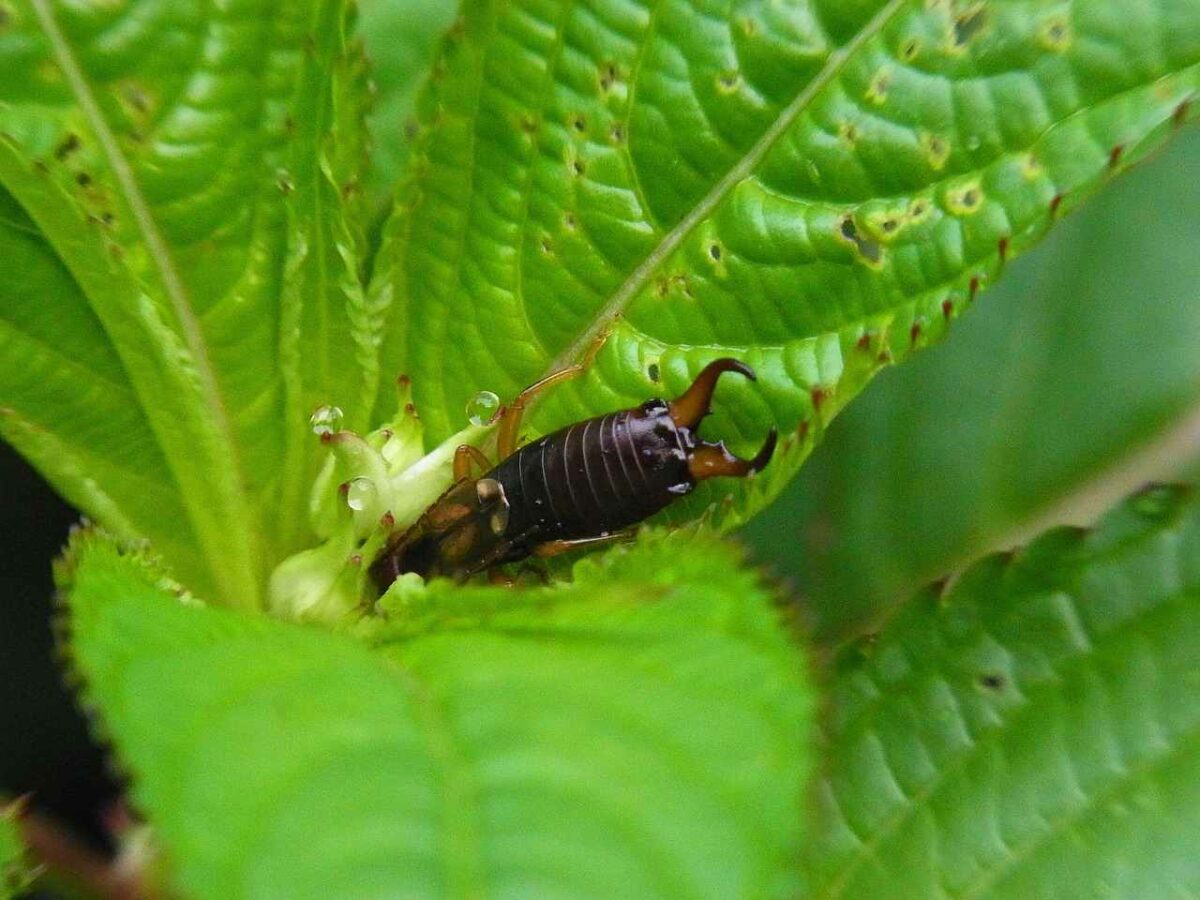Pincher bugs, often known as earwigs, are a common household pest that can be annoying. Earwigs are also known as pincher bugs. Although the pincers on these creepy crawlies’ posterior ends can give them an intimidating appearance, they do not threaten human beings in most cases.
However, they pose a risk to the health of plants and can be a bothersome presence inside the house if they get inside. In this piece, we will discuss ten effective strategies to get rid of earwigs.
Quick Access
Why Is Earbug Infest?
There are a few different reasons why earwigs will invade homes. Earwigs are drawn to dark and damp places, so if your home has any regions with a high humidity level, you may have an infestation of these pests. Basements, crawl spaces, and toilets are typical places where earwigs can live and breed. Earwigs may enter your home through cracks and fissures if your house has these openings. Earwigs do this for food and shelter.
Rotting leaves and plant detritus attract earwigs. They may visit if your residence has many plants. Eating leaves and blossoms in invaded fields can spread illness and harm plants. Earwigs can now enter homes seeking food. They devour plants, bugs, and other earwigs. Earwigs will likely invade your home if you regularly leave pet food or crumbs on the floor.
How To Get Rid Of Earwigs?
#1: Identify the Source
Finding the breeding ground of earwigs is the first step to get rid of earwigs. Earwigs are attracted to dark and wet environments; therefore, you should inspect your home and yard for moisture. Locate moisture sources such as damaged pipes, pools of water, and other such places. If you discover any, make the necessary repairs and remove the moisture.
#2: Remove Clutter
Because earwigs like to conceal themselves in disarray, always keeping your home clean and clear of disarray is essential. This will not only make it simpler to spot any earwig infestations, but it will also make it less desirable for them to remain in the area.
#3: Seal Cracks and Crevices
Earwigs can fit through the tiniest of gaps and fissures, so blocking off any holes in your home is essential. Windows, doors, and other openings should be weatherproofed with caulking or stripping. This will not only prevent earwigs from entering but also help save money on energy costs.
#4: Use Sticky Traps
Earwigs can be easily captured with the help of sticky traps. Position the traps where you have observed earwigs, and the insects will be drawn to the traps, where they will become trapped. Put the traps in dark and damp places, like beneath the sink, in the basement, or in the crawl space.
#5: Diatomaceous Earth
Earwigs can be exterminated with diatomaceous earth, a natural and non-toxic product. This substance can be employed. The fossilized remains of diatoms, a form of algae, are ground up into powder and used to make this product. Earwigs will perish after touching diatomaceous earth because it will cause them to lose their ability to retain water. It would help to sprinkle the powder in places where you have observed earwigs, such as beneath sinks and in basements.
#6: Use Boric Acid
Boric acid is a poisonous material that can be used to get rid of earwigs. Create a paste by combining the boric acid, sugar, and water in a bowl, and then spread the paste in the locations where you have observed earwigs. Earwigs will be drawn to the sugar, and the boric acid will eliminate them once they are there.
#7: Essential Oils
Essential oils, such as peppermint and lavender, can be utilized as an effective earwig deterrent. Spray the earwig-infested areas with a mixture that contains a few drops of essential oil and water that have been mixed. This will not only keep the earwigs away from your home but also leave them smelling clean.
#8: Cedar Oil
Earwigs can also be gotten rid of using cedar oil, which is another natural repellant that can be employed. Cotton balls soaked with cedar oil should be placed in places of the house where earwigs have been spotted. Earwigs will not come near your house if the aroma of cedar is there since it will cause them to flee.
#9: Use a Dehumidifier
A dehumidifier can help eliminate earwigs because these pests are drawn to damp environments. Earwigs will find it less enticing to stay in your home if you install a dehumidifier because it will remove excess moisture from the air. To maintain a dry environment within your home, set the dehumidifier to about 50 percent humidity.
#10: Call a Pest Control Professional
If you have tried all of these measures, but an earwig infestation still exists, it may be time to call a professional specializing in pest management. A qualified exterminator will have access to more potent insecticides and can assist you in locating the origin of the infestation. They can also offer pointers and recommendations for warding off earwig infestations in the future.
How To Keep Earwigs Away?
After eliminating the current earwig population in your house, you will need to take whatever precautions are necessary to stop new ones from moving in. Earwigs are hardy insects, but by employing a few straightforward strategies, you can ensure that they remain outside, where they belong, rather than making their way inside your home.
#1: Fill in the Cracks
If there is no way for them to enter your home, earwigs cannot find a way in. Make sure that none of your window screens have any holes in them, and use caulk to fill up any significant cracks or spaces that may be present on your window sills. You may ensure that your doors have a secure seal on the bottom by adjusting the hinges, or you can add rubber stoppers to fill the gaps in the seal. Additionally, it would help if you inspected your home to ensure that there are no significant spaces between the flooring and the baseboards.
#2: Fix Leaks
Moisture is one of the things that earwigs are drawn to most of all other factors. It won’t take long for earwigs and other insects to make a home in any cracks or crevices in your home due to water damage. Check your entire plumbing system to see if there are any dripping or leaking faucets or pipes. This will keep earwigs at bay and deter cockroaches, rodents, and other critters from establishing a nest in these humid regions.
#3: Remove Fallen Vegetation
Fermenting yard detritus such as leaves and twigs is a favorite activity of earwigs. In light of this, clear away any vegetation or leaf litter, particularly when the weather is damp. These things can entice earwigs and beetles to come to your yard, which increases the likelihood that they will come into your home.
#4: Purge the Gutters
Bacteria will begin to grow in the stagnant water that collects in obstructed gutters. They become increasingly vulnerable to earwigs and other parasites as time goes on. It is important to clean the gutters twice a year to ensure they continue functioning properly and keep water away from the foundation. Earwigs won’t be able to reproduce near your house due to this measure.
How To Find Earwigs?
Because of the unique pincers or forceps that protrude from their abdomen, earwigs may be identified with relative ease. One of the reasons why they appear to be so menacing and can be so threatening is because they have forceps. Earwigs, on the other hand, do not pose any health risks because they are not poisonous and do not transmit disease.
Adult earwigs have two sets of wings and typically range from five to twenty-five millimeters. Earwigs can also be identified by their characteristic wriggling motion. However, only some earwigs can fly, even those with a slower top speed than most other insects. They move much more quickly on the ground and will attempt to flee as quickly as possible if you discover where they have been hiding.
Conclusion
In conclusion, earwigs can be a bother, but they can be efficiently managed using appropriate strategies. You can successfully get rid of earwigs in your home if you find the source of the infestation, clear away the debris, seal any cracks or crevices, use traps, and use natural repellents. If, despite your efforts, you still find that you have an infestation, you shouldn’t be afraid to seek the assistance of a trained professional.

